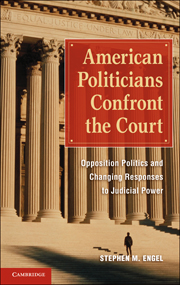 American Politicians Confront the Court
American Politicians Confront the Court Book contents
- Frontmatter
- Contents
- Acknowledgments
- Introduction
- PART I POLITICAL DEVELOPMENT AND ELECTED-BRANCH RELATIONS WITH THE JUDICIARY
- PART II HOSTILITY TO JUDICIAL AUTHORITY AND THE POLITICAL IDIOM OF CIVIC REPUBLICANISM
- PART III HARNESSING JUDICIAL POWER AND THE POLITICAL IDIOM OF LIBERAL PLURALISM
- 6 Clashing Progressive Solutions to the Political Problem of Judicial Power
- 7 A Polity Fully Developed for Harnessing (I)
- 8 A Polity Fully Developed for Harnessing (II)
- On the Return of Opposition Illegitimacy and the Prospects for New Development
- Index
- References
6 - Clashing Progressive Solutions to the Political Problem of Judicial Power
Published online by Cambridge University Press: 05 June 2012
- Frontmatter
- Contents
- Acknowledgments
- Introduction
- PART I POLITICAL DEVELOPMENT AND ELECTED-BRANCH RELATIONS WITH THE JUDICIARY
- PART II HOSTILITY TO JUDICIAL AUTHORITY AND THE POLITICAL IDIOM OF CIVIC REPUBLICANISM
- PART III HARNESSING JUDICIAL POWER AND THE POLITICAL IDIOM OF LIBERAL PLURALISM
- 6 Clashing Progressive Solutions to the Political Problem of Judicial Power
- 7 A Polity Fully Developed for Harnessing (I)
- 8 A Polity Fully Developed for Harnessing (II)
- On the Return of Opposition Illegitimacy and the Prospects for New Development
- Index
- References
Summary
Many accounts of federal judicial politics during the Progressive era – the 1890s through 1930s – note how Republican hold on the Senate and presidency allowed near total control over judicial appointments. Candidates were vetted for “their devotion to party principles and ‘soundness’ on major economic questions of the day.” Judges protected corporate interests against state and federal regulation of workplace conditions, wages, and hours. Judges gave constitutional interpretation a Republican cast, shorthanded by the economic doctrine of laissez-faire and its legal counterpart, liberty of contract.
Federal courts are thereby depicted as countermajoritarian. By resisting popular support for workplace and wage regulation, rulings fomented anti-judge hostility that culminated in Franklin Roosevelt's seemingly Jeffersonian attack in 1937, that is, his proposal to stack the Supreme Court and enlarge the lower federal judiciary to prevent judicial nullification of New Deal policy. The failure to pass various Progressive measures, including FDR's Court-packing proposal, are understood to be evidence of popular and elite acceptance of judicial independence if not outright supremacy.
This chapter challenges this account by focusing attention on assessments of whether, how, and why Progressive proposals failed. Progressives took an inconsistent stance toward federal judicial authority. While some offered the most virulent anti-Court rhetoric since the Jeffersonian years, Progressives proved unable to construct a single solution to the problem of legitimate judicial authority. This failure stemmed from a muddled tradition drawing on incongruent Jeffersonian and Lincolnian strands of Republicanism.
- Type
- Chapter
- Information
- American Politicians Confront the CourtOpposition Politics and Changing Responses to Judicial Power, pp. 225 - 284Publisher: Cambridge University PressPrint publication year: 2011


